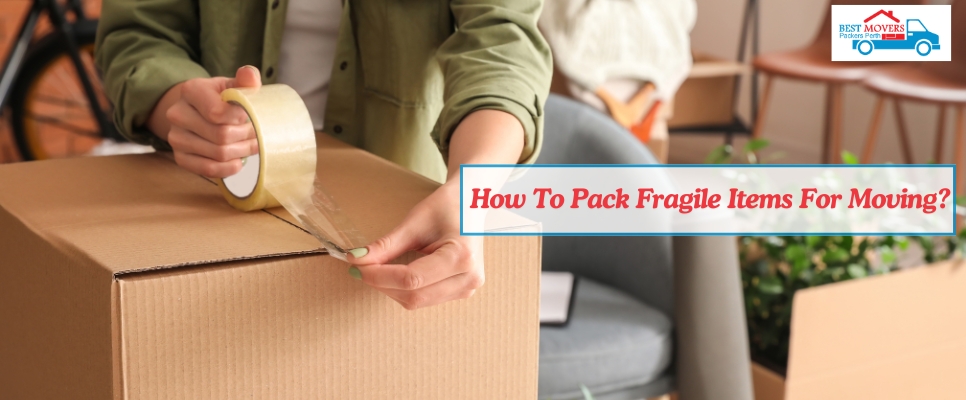Moving to a new place is an important decision you make. It can be exciting, but when it comes to packing fragile belongings and moving them to a new location, it becomes stressful. But it’s natural to worry and feel concerned about the safety of your precious belongings during the move. However, this concern is justified.
If you want your precious and fragile belongings to arrive safely at their destination, you need to know some packing strategies. If you pack your items effectively and properly, you’ll get your fragile items intact at a new location without any damage.
In this blog, we have listed some packing techniques for fragile and valuable items for moving. Read this blog further to get to know them.

Here Are Some Of The Techniques You Should Use To Pack Your Fragile Items
You can learn about some strategic techniques to pack your precious and fragile belongings, which are mentioned below, and make your move easier, smoother, and worry-free.
1. Gather The Suitable Packing Materials
The best packing materials guarantee that your fragile items will arrive safely at their destination without getting damaged during transportation. Don’t overlook this step; your fragile items could break or get damaged easily. You will end up regretting it later. If you don’t use safe and standard packing materials, there will be a high chance of breaking or damaging your fragile items. Packing materials include:
- High-quality moving boxes in various sizes
- Plenty of packing papers or newspapers
- Bubble wrap
- Packing tape
- Marker for labelling
- Padding materials like foam peanuts
- Cushioning materials
2. Choose The Right Box Size
Boxes come in various sizes. We recommend you choose the right box size and ensure they are of high quality. If your boxes are sturdy and of high quality, it will be easy to handle the weight of your fragile belongings. The one mistake that homeowners make is the use of larger boxes. When you can pack items in them, they require more packing materials. Instead, you can use small boxes for heavy items and larger boxes for lighter items to avoid overpacking.
3. Create A Base With Soft Packing Materials
Once you have packed your belongings and wrapped them properly, there is a technique to place them in the boxes. First, create a base using soft packing materials. You can use packing paper, bubble wrap, foam peanuts, or cushioning material. If these traditional materials are not in your home, you can use towels or old bedsheets to create a soft base. This base will work as a protection layer for your belongings making them less likely to be damaged during the moving process.
4. Declutter, Discard, Sell, And Donate
This is the perfect time to sort out all your belongings. Declutter the things that you no longer need in your house or office. You can declutter or discard the things, sell those in good condition, and donate furniture Perth your belongings that you no longer need to someone who could benefit from them.
5. Wrap Each Item Individually
You should wrap each item individually and check that the wrapped items are not packed too tightly or have too much space between them. Fill any remaining gaps with enough material to prevent movement during transportation. You can use packing tape to secure the wrapping layers effectively, and you should also consider using multiple layers of bubble wrap for added protection.

6. Clearly Label Your Boxes
It’s important to clearly label boxes with their contents so that you know exactly what’s inside each box. If you’re hiring movers, you need to mark your belongings clearly and properly in big letters. You can use a marker to write “FRAGILE ITEMS”, “VALUABLE ITEMS” or “HANDLE WITH CARE” in capital letters on the sides and tops of the boxes. This will help movers handle them carefully during transportation.
7. Fill The Remaining Gaps In The Boxes
It’s important to place larger items at the bottom and smaller items on top. Make sure that each item is properly cushioned or padded to prevent them from touching each other. If there are any gaps in the box, fill them with additional packing material such as bubble wrap, crumpled paper, or foam peanuts to minimize movement during transportation and prevent damage.
8. Pack Electronics Carefully
It’s important to pack delicate electronic devices carefully. If possible, you should use their original packaging. If you don’t have the original packaging, then you must wrap them in anti-static bubble wrap and use high-quality, strong boxes with extra padding. These devices are expensive and require special care during transit.
9. Hire Professional Packers And Movers
Hire professional packers and movers who have experience handling fragile items. You can be stress-free by knowing that they will safely pack fragile items and move them securely during transit. These professionals offer full-service moving experiences that include packing, moving, and unpacking services. This ensures a smoother and safer relocation process for your belongings.
10. Handle The Fragile Items With Care
This is the last but important step: Take your time and avoid rushing. It’s human nature to try to do things quickly, but remember that when it comes to moving fragile items, it’s important to take it slow. Instruct movers to carry fragile moving boxes, always lift and carry them with extra care. You can use dollies or carts to move boxes to reduce the risk of dropping or mishandling them. You can communicate with your professional movers and request that they drive slowly during transportation.
Conclusion
Packing fragile items for a move requires careful planning and the right materials. Use sturdy boxes, plenty of packing paper or bubble wrap, and cushioning materials. Wrap each item individually, fill gaps with padding, and label boxes as “FRAGILE ITEMS”. Consider hiring professionals for delicate items. Take your time, handle it with care, and communicate with movers for a safe relocation.










